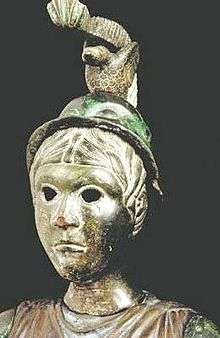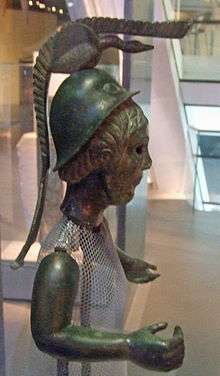Brigid
Brigit, Brigid or Bríg (/ˈbrɪdʒɪd, ˈbriːɪd/, Old Irish Irish pronunciation: [ˈbʲɾʲiʝidʲ]; meaning 'exalted one')[1] is a goddess of pre-Christian Ireland. She appears in Irish mythology as a member of the Tuatha Dé Danann, the daughter of the Dagda and wife of Bres, with whom she had a son named Ruadán.
| Brigid | |
|---|---|
 | |
| Texts | Lebor Gabála Érenn |
| Personal information | |
| Parents | Dagda |
| Siblings | Cermait, Aengus, Aed, Bodb Derg, Brigid the Healer, Brigid the Smith |
She is associated with the spring season, fertility, healing, poetry and smithcraft. Cormac's Glossary, written in the 10th century by Christian monks, says that Brigid was "the goddess whom poets adored" and that she had two sisters: Brigid the healer and Brigid the smith.[2][3] This suggests she may have been a triple deity.[4]

Saint Brigid shares many of the goddess's attributes and her feast day on 1 February was originally a pagan festival (Imbolc) marking the beginning of spring. It has thus been argued that the saint is a Christianization of the goddess.[5]
Familial relations
She is identified in Lebor Gabála Érenn as a daughter of the Dagda and a poet. The same passage mentions that she has two oxen, Fe and Men, that graze on a plain named after them, Femen; elsewhere Fe and Men are described as the two oxen of Dil, "radiant of beauty," which may be a byname for Brigid.[6] She also possessed the king of boars, Torc Triath, and Cirb, king of wethers (sheep), from whom Mag Cirb is named.[7] The animals were said to cry out a warning and thus Brigid is considered the guardian of domesticated animals.[8] As the daughter of Dagda, she is also the half sister of Cermait, Aengus, Aed and Bodb Derg.
Overview
In Cath Maige Tuireadh, Bríg invents keening, a combination of weeping and singing, while mourning for her son Ruadán, after he is slain while fighting for the Fomorians. She is credited in the same passage with inventing a whistle used for night travel.[9]
Brigid is considered the patroness of poetry, smithing, medicine, arts and crafts, cattle and other livestock, sacred wells, serpents (in Scotland) and the arrival of early spring.[10][11] In the Christian era, nineteen nuns at Kildare tended a perpetual flame for the Saint, which is widely believed to be a continuation of a pre-Christian practice of women tending a flame in her honour.[12][13] Her festival day, Imbolc is traditionally a time for weather prognostication:
Thig an nathair as an toll |
The serpent will come from the hole |
In her English retellings of Irish myth, Lady Augusta Gregory describes Brigit as "a woman of poetry, and poets worshipped her, for her sway was very great and very noble. And she was a woman of healing along with that, and a woman of smith's work, and it was she first made the whistle for calling one to another through the night."[14]
A possible British and continental counterpart Brigantia seems to have been the Celtic equivalent of the Roman Minerva and the Greek Athena.[15] goddesses with very similar functions and apparently embodying the same concept of elevated state, whether physical or psychological.
She is the goddess of all things perceived to be of relatively high dimensions such as high-rising flames, highlands, hill-forts and upland areas; and of activities and states conceived as psychologically lofty and elevated, such as wisdom, excellence, perfection, high intelligence, poetic eloquence, craftsmanship (especially blacksmithing), healing ability, druidic knowledge and skill in warfare. A number of these associations are attested in Cormac's Glossary.
Brigid and Saint Brigid
In the Middle Ages, the goddess Brigid was syncretized with the Christian saint of the same name. According to medievalist Pamela Berger, Christian "monks took the ancient figure of the mother goddess and grafted her name and functions onto her Christian counterpart," St. Brigid of Kildare.[5]
St. Brigid is associated with perpetual, sacred flames, such as the one maintained by 19 nuns at her sanctuary in Kildare, Ireland. The sacred flame at Kildare was said by Giraldus Cambrensis and other chroniclers to have been surrounded by a hedge, which no man could cross. Men who attempted to cross the hedge were said to have been cursed to go insane, die or be crippled.[12][13]
The tradition of female priestesses tending sacred, naturally occurring eternal flames is a feature of ancient Indo-European pre-Christian spirituality. Other examples include the Roman goddess Vesta, and other hearth-goddesses, such as Hestia.
Both the goddess and saint are associated with holy wells, at Kildare and many other sites in the Celtic lands. Well dressing, the tying of clooties to the trees next to healing wells, and other methods of petitioning or honoring Brigid still take place in some of the Celtic lands and the diaspora.[16][17]
Festivals
Saint Brigid's feast day is on 1 February celebrated as St Brigid's Day in the Roman Catholic Church, the Eastern Orthodox Church and by the Anglican Communion. The Gaelic festival coincides with Imbolc, which is a pagan festival associated with the goddess Brigid.[18]
Neo-Pagan revival
Brigid is an important figure for modern pagans, who emphasize her triple aspect. She is sometimes worshipped in conjunction with Cernunnos.[19]
Other names and etymology
Old Irish Brigit [ˈbʲɾʲiʝidʲ] came to be spelled Briġid and Brighid [bʲɾʲiːdʲ] by the modern Irish period. Since the spelling reform of 1948, this has been spelled Bríd [bʲɾʲiːdʲ]. The earlier form gave rise to various forms in the languages of Europe, starting from the Medieval Latin Brigit /ˈbridʒit/, suggested by the written form, and from there to various modern forms, such as English Bridget and Bridgit (now commonly seen as Brigid), French Brigitte, Swedish Birgitta, Italian Brigida and Finnish Piritta.
The name is derived from Proto-Celtic *Brigantī and means "The High One", cognate with the name of the ancient British goddess Brigantia (goddess), the Old High German personal name Burgunt, and the Sanskrit word Bṛhatī (बृहती) "high", an epithet of the Hindu dawn goddess Ushas. The ultimate source is Proto-Indo-European *bʰr̥ǵʰéntih₂ (feminine form of *bʰérǵʰonts, "high"), derived from the root *bʰerǵʰ- ("to rise").[20][21] Xavier Delamarre, citing E. Campanile suggests that Brigid could be a continuation of the Indo-European dawn goddess.[1]
- Brìghde/Brìde (Scotland)
- Ffraid (Wales) (also Braint, alt. Breint, the name of a river in Anglesey. Because of Welsh pronunciation mutations and accompanying devoicing after "t" in Sant, the original mutated form of her name, *Fraid (< *Braid), changes to Ffraid in some place names such as Llansanffraid = Saint Bride's Village and Llansantffraid-ym-Mechain.[22]
- Breo Saighead (the fiery arrow – a folk etymology found in Sanas Cormaic, but considered very unlikely by etymologists)
See also
- Brigid of Ireland
- Brigid's cross
- Imbolc
- List of Irish-language given names
- Saraswati
- Maman Brigitte
Notes
- Campbell, Mike Behind the Name. See also Xavier Delamarre, brigantion / brigant-, in Dictionnaire de la langue gauloise (Éditions Errance, 2003) pp. 87–88: "Le nom de la sainte irlandaise Brigit est un adjectif de forme *brigenti… 'l'Eminente'." Delamarre cites E. Campanile, in Langues indo-européennes ("The name of the Irish Saint Brigid is an adjective of the form *brigenti… 'the Eminent'"), edited by Françoise Bader (Paris, 1994), pp. 34–40, that Brigid is a continuation of the Indo-European goddess of the dawn like Aurora.
- Ó hÓgáin, Dáithí. Myth, Legend & Romance: An encyclopaedia of the Irish folk tradition. Prentice Hall Press, 1991. p.60
- Wright, Brian. Brigid: Goddess, Druidess and Saint. The History Press, 2011. pp.26-27
- Sjoestedt, Marie-Louise (18 September 2000). Celtic Gods and Heroes. Dover Publications. pp. 21, 25. ISBN 0-486-41441-8.
- Berger, Pamela (1985). The Goddess Obscured: Transformation of the Grain Protectress from Goddess to Saint. Boston: Beacon Press. ISBN 9780807067239.
- The Metrical Dindsenchas: "Mag Femin, Mag Fera, Mag Fea," Poem 36
- Macalister, R. A. Stewart. Lebor Gabála Érenn. Part IV. Irish Texts Society, Dublin, 1941. § VII, First Redaction, ¶ 317.
- Ellis, Peter Berresford. "Celtic Women." Wm. B. Erdmans Publishing, Grand Rapids, MI, 1995, p. 28.
- Cath Maige Tuired (The Second Battle of Mag Tuired), translated by Elizabeth A. Gray. ¶ 125
- Carmichael, Alexander (1900) Carmina Gadelica: Hymns and Incantations, Ortha Nan Gaidheal, Volume I, p. 169 The Sacred Texts Archive
- Jones, Mary. "Brigit". Jones' Celtic Encyclopedia. Archived from the original on 28 April 2009. Retrieved 14 December 2012.
- "Saint Brigid: St Brigid's Fire". Cill Dara Historical Society. Retrieved 28 December 2012.
- Cambrensis, Giraldus. "The Topography of Ireland" (PDF). York University. pp. 54, 59. Retrieved 28 December 2012.
- Gregory, Isabella Augusta (1904). Gods and fighting men : the story of the Tuatha de Danann and the Fiana of Ireland. Yeats, W. B. [Lexington, KY]: [publisher not identified]. p. 24. ISBN 9781495385148. OCLC 907958219.
- Encyclopædia Britannica: Celtic Religion
- Healy, Elizabeth (2002) In Search of Ireland's Holy Wells. Dublin, Wolfhound Press ISBN 0-86327-865-5 pp. 12–19, 27, 56–7, 66, 69, 81.
- Logan, Patrick (1980) The Holy Wells of Ireland. Buckinghamshire, Colin Smythe Limited. ISBN 0-86140-046-1. pp. 22–3, 95.
- John T. Koch (2006). Celtic Culture: A Historical Encyclopedia. ABC-CLIO. p. 287. ISBN 978-1-85109-440-0. Retrieved 14 March 2013.
- Magliocco, Sabina (28 January 2001). Neo-pagan sacred art and altars : making things whole. Jackson: University Press of Mississippi. p. 30. ISBN 9781578063918. OCLC 46573490.
- Matasović, Ranko, Etymological Dictionary of Proto-Celtic (Leiden Indo-European Etymological Dictionary Series no. 9), Brill, 2009, pp. 78-79
- Mallory, J. P. and Adams, Douglas Q. (eds.), Encyclopedia of Indo-European Culture, Taylor & Francis, 1997, p. 269
- Hilaire Wood. "Brigit's Forge". Retrieved 24 April 2015.
References
- Bitel, Lisa M. 2001. St. Brigit of Ireland: From Virgin Saint to Fertility Goddess
- MacKillop, James. 1998. Dictionary of Celtic Mythology. (Oxford: Oxford University Press) ISBN 0-19-280120-1
- The Slaney Press. 1994. Lady Gregory's Complete Irish Mythology. (London: The Slaney Press)
Further reading
- Catháin, Séamas Ó. “Hearth-Prayers and Other Traditions of Brigit: Celtic Goddess and Holy Woman.” The Journal of the Royal Society of Antiquaries of Ireland, vol. 122, 1992, pp. 12–34. JSTOR, www.jstor.org/stable/25509020. Accessed 7 May 2020.
External links
| Wikimedia Commons has media related to Brigid. |